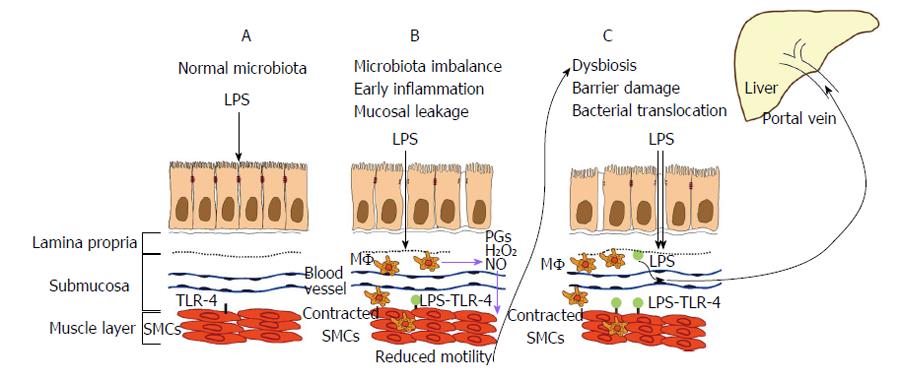Copyright
©The Author(s) 2015.
World J Gastrointest Pathophysiol. Nov 15, 2015; 6(4): 99-109
Published online Nov 15, 2015. doi: 10.4291/wjgp.v6.i4.99
Published online Nov 15, 2015. doi: 10.4291/wjgp.v6.i4.99
Figure 1 The results of intestinal disorders that are associated with impaired motility.
A: Normal conditions with intestinal mucosa tolerance; B: In the presence of microbiota imbalance, intestinal mucosa is characterized by a leak and mild inflammatory infiltrate. The subsequent passage of modest quantities of lipopolysaccharides (LPS) induces activation of resident macrophages (MΦ) with the release of inflammatory mediators, such as prostaglandins (PGs) and nitric oxide (NO). LPS can also reach the muscle layer and bind to smooth muscle cell (SMC) toll-like receptor 4 (TLR-4). Both conditions cause morpho-functional changes of SMCs. The reduced intestinal motility further induces intestinal microbiota imbalance, which leads to dysbiosis; C: Dysbiosis induces barrier damage and relevant bacterial and LPS translocation. The large amount of translocated LPS reaches the blood vessels through the portal vein and reaches the liver.
- Citation: Carotti S, Guarino MPL, Vespasiani-Gentilucci U, Morini S. Starring role of toll-like receptor-4 activation in the gut-liver axis. World J Gastrointest Pathophysiol 2015; 6(4): 99-109
- URL: https://www.wjgnet.com/2150-5330/full/v6/i4/99.htm
- DOI: https://dx.doi.org/10.4291/wjgp.v6.i4.99









